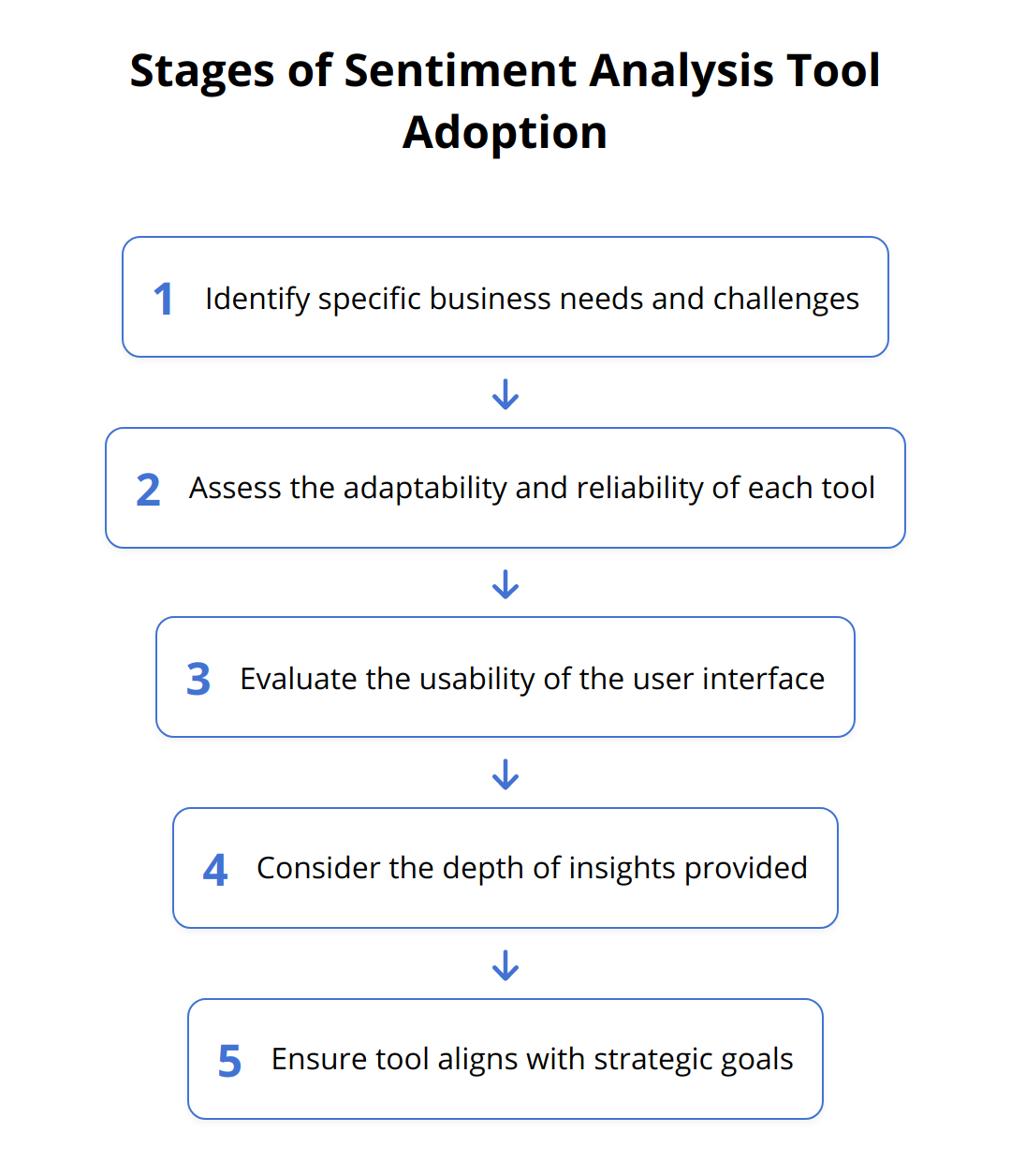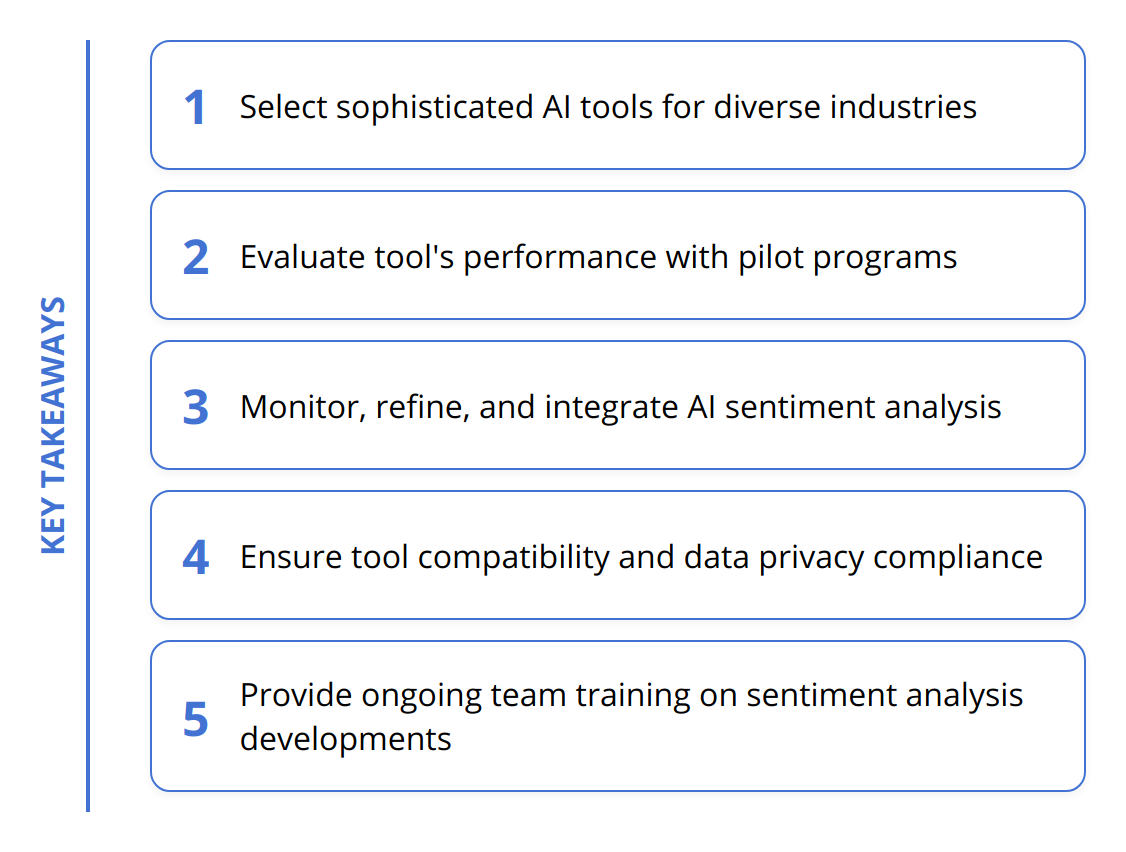We at Emplibot understand the transformative impact of sentiment analysis tools, especially when powered by artificial intelligence, on businesses today. Artificial intelligence has revamped the way companies discern customer emotions, opinions, and attitudes from text data.
Selecting and effectively implementing the right AI sentiment analysis tool can be a game-changer for your business operations. Let’s explore how to maximize the advantages of these tools, address the inherent challenges, and pave the way for smarter, data-driven decisions.
Inhalt
ToggleHarnessing AI for In-Depth Sentiment Analysis
As businesses strive to stay ahead, understanding the nuances of customer feedback is no longer just an option—it’s a competitive necessity. Sentiment analysis is the key to unlocking those nuances, enabling businesses to decode the complex language of customer sentiments. This is not a one-time activity but a continuous process of gathering and interpreting data to keep your customer relationships proactive and responsive.
The inclusion of AI in sentiment analysis transforms this process from simple positive, negative, or neutral classifications to a sophisticated understanding of moods, emotions, and even sarcasm. AI does this through machine learning algorithms that get smarter over time, efficiently parsing through text and learning from its intricate patterns.

Empower Your Strategy with AI Sentiment Analysis
The practical benefits of using AI for sentiment analysis are significant:
-
Speed and Efficiency: AI systems can analyze huge volumes of customer interactions rapidly, providing real-time feedback which is essential for timely business decisions.
-
Consistency: Human interpretation of emotions can be subjective and inconsistent. AI offers a level of uniformity in processing and analyzing sentiments across the board.
-
Scalability: As your data grows, AI scales with your needs. Effortlessly process more customer feedback than a team of human analysts ever could.
-
Deep Insights: Through AI, businesses can detect sentiment subtleties that might be missed by manual analysis, such as cultural nuances or the context behind the words.
However, integrating AI-powered sentiment analysis into your operations can present challenges, including the nuanced accuracy needed to discern complex emotional expressions in different languages and dialects.
To conquer these challenges, here’s how you can proceed:
-
First, select a sophisticated AI tool that’s proven effective across different industries. Check out leaders in the space like Google Cloud Natural Language or IBM Watson which are known for their advanced sentiment analysis capabilities.
-
Begin with a pilot program to evaluate the tool’s performance with your specific data. Aim for a solution that can be finely tuned to pick up the unique jargon and idioms of your customers.
-
Don’t forget to monitor and refine the AI tool’s performance. Utilize the feedback and results to further train and adapt the algorithm to your business context.
-
Lastly, AI tools are not standalone solutions. Make sure to integrate sentiment analysis into your broader data analytics strategy for a comprehensive understanding of customer engagement and behavior.

Remember, while AI brings unprecedented benefits, it is not immune to error. Always review its output with a critical eye and use it as a supplementary tool to your wider business intelligence and human judgment.
In closing this chapter, by choosing the right AI tools and approaches, and constantly refining them, you can effectively mine the wealth of information hidden in the sentiments expressed by your customers. This will lead to improved customer experiences, product enhancements, and ultimately, a solid boost to your business’s bottom line.
Choosing Your Sentiment Analysis Ally
Navigating the landscape of AI-powered sentiment analysis tools requires attention to detail, a keen understanding of your specific needs, and an unswerving commitment to quality data interpretation. Plunging into this choice without a clear set of criteria is akin to sailing without a compass—you might move forward, but you’re unlikely to reach the desired destination.

Key Selection Criteria
Picking the best sentiment analysis tool hinges on several non-negotiable factors. Reliability stands paramount; the chosen tool must consistently deliver accurate sentiment analysis across a spectrum of use cases. Adaptability is equally pivotal—can the tool accurately understand sector-specific jargon and adapt to new linguistic trends? The user interface should empower users to operate efficiently without a steep learning curve. Moreover, a tool’s ability to offer high-level insights is indispensable for informing strategic decisions, rather than just churning out raw data.
Industry Leaders in Sentiment Analysis
Several tools rise above the fray with robust feature sets and industry validation. Look at MonkeyLearn, known for its customizable models and seamless integration into existing workflows, making it a strong candidate for businesses of all sizes. Another frontrunner is Amazon Comprehend, providing deep learning-powered insights with the backing of a tech giant. Businesses should scrutinize these options, among others, to ensure alignment with their unique analytical goals.

Real-World Wins Through AI Sentiment Analysis
Companies embracing AI-fueled sentiment analysis have woven success stories worth noting. Airbnb, for instance, has harnessed sentiment analysis to fine-tune its offerings based on guest feedback, which is a strategy that can be applied to any customer-centric enterprise. Meanwhile, a major automotive player like Ford has turned to sentiment analysis to gauge public reaction to new models and features, consequently steering its marketing efforts with greater precision.
Ever-Evolving Tools for Tomorrow
Evolving the sentiment analysis toolkit must be an ongoing endeavor. The scene is rife with examples of businesses that regularly refine the capabilities of their tools to maintain accuracy and stay abreast of the shifting tides of public opinion. Armed with this adaptive mindset and embracing AI’s transformative power, businesses can position themselves at the vanguard of customer insight and engagement.
Forge ahead with these principles in mind, and the sentiment analysis tool you finally zero in on will not just serve you—it will propel you.
Smooth Sentiment Analysis Integration
Integrating AI-powered sentiment analysis into your business is more than just a technical update; it’s a strategic move towards enhanced understanding of your customer base. It demands careful planning and consideration to ensure seamless adoption within your existing systems. In navigating this journey, embrace practices that foster efficient integration, bolster staff expertise, and enable agile responses to sentiment-driven insights.

Effective system integration ensures that sentiment analysis tools work in harmony with your current infrastructure. Start by mapping out all the customer touchpoints—social media, customer service channels, reviews, and surveys—where user-generated content is abundant. Ensure the tool you choose can pull data from these sources without friction. For example, tools such as Smart Automation Workflows can aid in connecting disparate systems with minimal downtime.
Educating your team about the fundamentals of sentiment analysis is a critical step. This doesn’t have to be complex; clear, concise, and actionable training modules will do the trick. Your staff should understand how sentiment analysis works, why it’s important, and how they can use it to elevate their work. A well-informed team will be better equipped to interpret the sentiment data meaningfully and make customer-centric decisions.
Once the sentiment analysis is up and running, the real work begins. Meticulously track and evaluate the outcomes of the sentiment analysis to fine-tune products, services, or marketing campaigns. Constant monitoring means you can quickly identify emerging trends or shifts in customer mood. Consider using a platform like Automated Reporting Tools for efficient tracking and sharing of insights across the board.
To get you started, here are practical tips:
-
Ensure compatibility: Verify that the sentiment analysis tool integrates with the platforms your customers use most.
-
Data Privacy Compliance: Check that the tool aligns with data protection regulations relevant to your customer demographic.
-
Ongoing Training: Set up regular training refreshers to keep the team sharp and informed about the latest sentiment analysis developments.
-
Agile Action Plans: Create a responsive framework that enables swift action based on sentiment analysis findings.
By following these steps and fostering a culture attuned to the value of sentiment analysis, your company can anticipate customer needs better and stay one step ahead of competitors. With smart integration, informed staff, and active monitoring, sentiment analysis will not only inform your strategy but also drive its evolution.
Navigating AI Sentiment Analysis Challenges
Sifting through customer sentiments with AI tools is more than just technical—it’s an intricate dance with language, emotion, and data ethics that requires attention and finesse. As we forge deeper into the terrain of AI-powered sentiment analysis, tackling accuracy and contextual limitations, privacy concerns, and ethical considerations is paramount.
AI-Powered Tools: Ensuring Precision Amidst Nuance
Accuracy is the bedrock upon which AI sentiment analysis stands. Yet, nuances in human language often flummox even the most sophisticated algorithms. Here’s how to tighten the accuracy screws of your AI tools:
-
Train your AI models using diverse datasets that include idiomatic expressions, slang, and industry-specific terms.
-
Incorporate feedback loops where AI predictions are constantly reviewed and corrected, providing ongoing learning opportunities for the system.
-
Collaborate with linguists or domain experts to refine the context-sensitivity of your AI, tailoring it to discern subtleties within specific audiences or cultural niches.
These practical steps help AI tools tap into the subtle undercurrents of customer communication, allowing them to differentiate between a genuinely disgruntled customer and one expressing mock dissatisfaction tongue-in-cheek.
Safeguarding Privacy in a Data-Driven World
Privacy is not only a right but a cornerstone of customer trust. Here’s how to handle data responsibly while using sentiment analysis tools:
-
Ensure any AI tools for sentiment analysis comply with global privacy regulations like GDPR or CCPA.
-
Employ data anonymization techniques so sentiment analysis can proceed without compromising individual identity.
-
Be transparent with customers about the data being collected and how it’s used, building trust through clarity.
By adopting privacy-compliant sentiment analysis, you’re not just legal; you’re telling customers they’re valued – a sentiment that’s bound to resonate well.
Adhering to High Ethical Standards With AI Sentiment Analysis
The power of AI comes with the responsibility to use it wisely and humanely. Stick to these ethical principles:
-
Avoid biased language in the training dataset to prevent skewed analysis that could influence business decisions unfairly.
-
Develop clear guidelines on how sentiment analysis results are used, maintaining human oversight, especially when it relates to impactful decisions.
-
Stay informed on AI ethics with resources such as Ethical AI Practices, to keep your strategies aligned with best practices.
By championing accuracy, privacy, and ethics, we ensure sentiment analysis tools are not just sharp, but wielded with care. The integrity of your use of AI in sentiment analysis is, after all, a direct reflection of your brand’s reputation. Keep refining these areas, and your sentiment analysis will be a robust yet considerate force within your business arsenal.
Wrapping Up
The journey we’ve embarked on today highlights the transformative power of AI-powered sentiment analysis tools. By harnessing advanced algorithms and machine learning, businesses stand to gain an unprecedented understanding of customer sentiments. The advantages are clear: real-time feedback, consistent and objective analysis, and the ability to scale as your data grows, all of which contribute to deeper insights into customer emotions and opinions.

Embracing these tools means embracing a future where customer feedback becomes the central pillar of your business strategy, leading to improved products, services, and customer relations.
To truly benefit from AI in sentiment analysis, organizations must foster an environment of continuous learning and adaptation. As language evolves and customer preferences shift, your AI systems must adapt just as quickly. This calls for a dedication to continuous improvement, regular training, and keeping pace with the latest developments in AI technology.
Looking forward, the path with AI sentiment analysis promises to be one of discovery and growth. As businesses, we must leverage the full potential of AI tools to stay ahead in a market that increasingly values the voice of the customer. Emplibot enables companies to do just that, by ensuring that your WordPress site is filled with SEO-friendly articles that keep your customers engaged and informed.
By integrating sentiment analysis into your marketing automation, such as with marketing automation solutions, you gain the ability to transform insights into action. Here are some steps to maintain the momentum in leveraging AI:
-
Periodically assess the AI tool’s accuracy and refine its learning algorithms
-
Stay updated on privacy laws and ethical use of AI to maintain customer trust
-
Prepare your team to adopt new tools and strategies to effectively respond to sentiment analysis insights
With AI sentiment analysis, each piece of feedback, each shared experience, becomes a guide pointing your business toward better service, sharper marketing, and more impactful products. Move forward with confidence, knowing that your customers’ voices are not just heard but are actively shaping the future of your brand.











